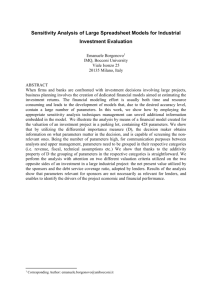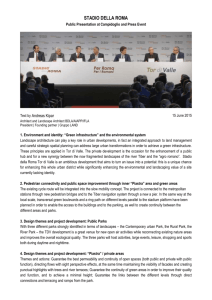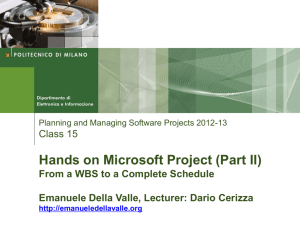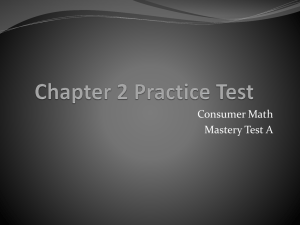P&MSP2010_05_Scheduling
advertisement
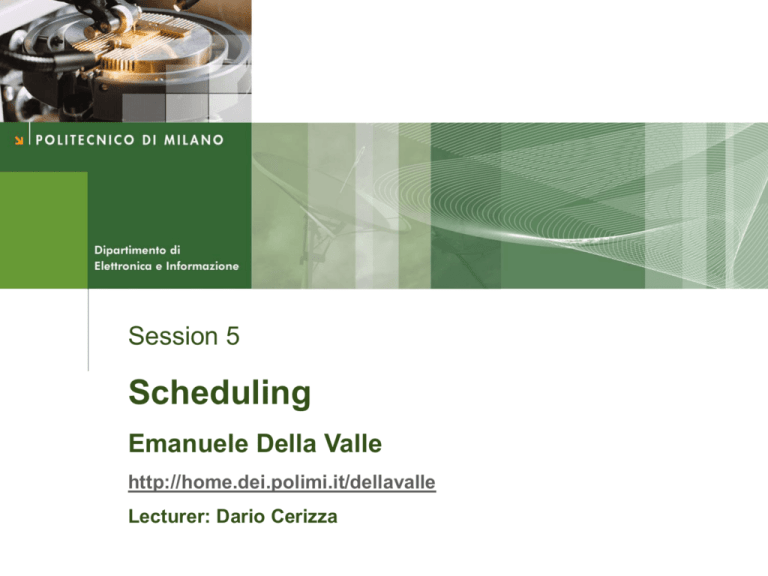
Session 5 Scheduling Emanuele Della Valle http://home.dei.polimi.it/dellavalle Lecturer: Dario Cerizza Credits 2 This slides are partially based on CEFRIEL’s slides for PMI Certification and largely based on Prof. John Musser class notes on “Principles of Software Project Management” Original slides are available at http://www.projectreference.com/ Reuse and republish permission was granted Planning and Managing Software Projects – Emanuele Della Valle Today Session 4 review Scheduling Fundamentals Scheduling Techniques • Network Diagrams • Bar Charts Schedule Optimization Techniques Mythical Man-Month Planning and Managing Software Projects – Emanuele Della Valle 3 Session 4 Review WBS Estimation Planning and Managing Software Projects – Emanuele Della Valle 4 Session 4 Review WBS Types: Process, Product, Hybrid Formats: Outline or graphical organizational chart High-level WBS does not show dependencies or durations WBS becomes input to many things, esp. schedule What hurts most is what’s missing Planning and Managing Software Projects – Emanuele Della Valle 5 Session 4 Review Estimation 6 “The single most important task of a project: setting realistic expectations. Unrealistic expectations based on inaccurate estimates are the single largest cause of software failure.” Futrell, Shafer, Shafer, “Quality Software Project Management” Session 4 continuation • http://www.emanueledellavalle.org/slides/P&MSP2009_ 05_WBS-Estimation-&-Scheduling.ppt – 55. Effort Estimation Planning and Managing Software Projects – Emanuele Della Valle Session 4 Review Estimation History is your best ally • Especially when using Function Points, LOC (Lines of Code), … Use multiple methods if possible • This reduces your risk • If using “experts”, use two Get buy-in Remember: it’s an iterative process! Know your “presentation” techniques Planning and Managing Software Projects – Emanuele Della Valle 7 Session 4 Review Estimation Bottom-up – More work to create but more accurate – Often with Expert Judgment at the task level Top-down – Used in the earliest phases – Usually as is the case with Analogy or Expert Judgment Analogy – Comparison with previous project: formal or informal Expert Judgment – Via staff members who will do the work – Most common technique along with analogy – Best if multiple ‘experts’ consulted Planning and Managing Software Projects – Emanuele Della Valle 8 Session 4 Review Estimation 9 Parametric Methods • Know the trade-offs of: LOC & Function Points Function Points • Benefit: relatively independent of the technology used to develop the system • We will re-visit this briefly later in semester (when discussing “software metrics”) Planning and Managing Software Projects – Emanuele Della Valle Today Session 4 review Scheduling Fundamentals Scheduling Techniques • Network Diagrams • Bar Charts Schedule Optimization Techniques Mythical Man-Month Planning and Managing Software Projects – Emanuele Della Valle 10 Scheduling Fundamentals Planning, Estimating and Scheduling Initial Planning: – Why - SOW, Charter – What/How (partial/1st pass) - WBS Other planning documents - Software Development Plan, Risk Mgmt., Cfg. Mgmt. Estimating – How much/How long - Size (quantity/complexity) and Effort (duration) It’s an iterative process Scheduling – In which order - Precedence, concurrences, lag & lead times, slack & float, … It’s an iterative process Planning and Managing Software Projects – Emanuele Della Valle 11 Scheduling Fundamentals What Scheduling is Once tasks (from the WBS) and size/effort (from estimation) are known: then schedule • Define the start and end time of each activity Objective: trade-off of six objectives • Primary objectives 1. Best time 2. Least cost 3. Least risk • Secondary objectives 4. Evaluation of schedule alternatives 5. Effective use of resources 6. Communications Planning and Managing Software Projects – Emanuele Della Valle 12 Scheduling Fundamentals Terminology: Precedence and Concurrence Precedence: • A task that must occur before another is said to have precedence of the other Concurrence: • Concurrent tasks are those that can occur at the same time (in parallel) Planning and Managing Software Projects – Emanuele Della Valle 13 Scheduling Fundamentals Terminology: Four task relationship types 14 Finish-to-start: “A f-to-s B”: the initiation of the successor activity depends upon completion of the predecessor activity Start-to-start: “A s-to-s B”: the initiation of successor activity depends upon initiation of the predecessor activity FS A A SS B Finish-to-finish: “A f-to-f B“: the A completion of the successor activity depends upon completion of the predecessor activity FF B Start-to-finish: “A s-to-f B“: the completion of the successor activity depends upon initiation of the predecessor activity Planning and Managing Software Projects – Emanuele Della Valle B A SF B Scheduling Fundamentals Terminology: Lag Time 15 It means a delay between tasks in sequence Example: if "A f-to-s B" and lag is equal to 10, B can start only 10 days after A end A FS + lag B time Lag Time Planning and Managing Software Projects – Emanuele Della Valle Scheduling Fundamentals Terminology: Lead Time 16 It means an advance between tasks in sequence Example: if "A f-to-s B" and lead is equal to 10, B can start 10 days before A end A FS - lead B time Planning and Managing Software Projects – Emanuele Della Valle Scheduling Fundamentals Terminology: Slack & Float 17 When then schedule contains several tasks, it may happen that there is some “free” time between tasks FS FS Slack Time Slack & Float: synonymous terms • We’ll use Slack Two types of slack time: Free Slack and Total Slack Planning and Managing Software Projects – Emanuele Della Valle Scheduling Fundamentals Terminology: Free Slack Free Slack: Maximum delay of a task without causing a delay for any downstream task Example • A and B can be activated as soon as possible • Relationships – “A finish-to-start C” – “B finish-to-start C” Free Slack of Task B Free Slack of Task B = Late Finish of B – Early Finish of B = Late Start of B – Early Start of B Planning and Managing Software Projects – Emanuele Della Valle 18 Scheduling Fundamentals Terminology: Total Slack 19 Total Slack: Maximum delay of a task without causing a delay for the total project (it can cause delays to other tasks) Normally, if not specified, slack stands for total slack Planning and Managing Software Projects – Emanuele Della Valle Scheduling Fundamentals Terminology: Milestones Identify crucial points in your schedule Have a duration of zero Shown as inverted triangle or a diamond Often used at “review” or “delivery” times • Or at end or beginning of phases • Ex: Software Requirements Review (SRR) • Ex: User Sign-off Can be tied to contract terms Planning and Managing Software Projects – Emanuele Della Valle 20 Scheduling Fundamentals Terminology: Milestones examples Planning and Managing Software Projects – Emanuele Della Valle 21 Scheduling Fundamentals Terminology: Four Dependency Types 22 1. Mandatory Dependencies • • • • “Hard logic” dependencies Nature of the work dictates an ordering Ex: UI design precedes UI implementation Ex: Coding has to precede testing 2. Discretionary Dependencies • • • • “Soft logic” dependencies Determined by the project management team Process-driven Ex: Discretionary order of creating certain modules NOTE: substantial process innovation often take place when “hard logic” dependencies are shown to be wrong • Ex: Test first approaches Planning and Managing Software Projects – Emanuele Della Valle Scheduling Fundamentals Terminology: Four Task Dependency Types 3. External Dependencies • Outside of the project itself • Ex: Release of 3rd party product; contract signoff • Ex: stakeholders, suppliers, year end 4. Resource Dependencies • Two task rely on the same resource • Ex: You have only one DBA but multiple DB tasks Planning and Managing Software Projects – Emanuele Della Valle 23 Today Session 4 review Scheduling Fundamentals Scheduling Techniques • Network Diagrams • Bar Charts Schedule Optimization Techniques Mythical Man-Month Planning and Managing Software Projects – Emanuele Della Valle 24 Scheduling Techniques Network Diagrams • CPM • PERT Bar Charts • Gantt Chart • Milestone Chart Planning and Managing Software Projects – Emanuele Della Valle 25 Scheduling Techniques Network Diagrams Developed in the 1950’s A graphical representation of the tasks necessary to complete a project Visualizes the flow of tasks & relationships Planning and Managing Software Projects – Emanuele Della Valle 26 Network Diagrams CPM & PERT CPM • Critical Path Method PERT • Program Evaluation and Review Technique Sometimes treated synonymously All are models using network diagrams Planning and Managing Software Projects – Emanuele Della Valle 27 Network Diagrams Two classic formats Two classic formats • AOA: Activity on Arrow • AON: Activity on Node Each activity labeled with • Identifier (usually a letter/code) • Duration (in standard unit like days) There are other variations of labeling There is 1 start & 1 end event Time goes from left to right Planning and Managing Software Projects – Emanuele Della Valle 28 Network Diagrams Formats Planning and Managing Software Projects – Emanuele Della Valle 29 Network Diagrams Formats AOA • Activities on Arrows • Circles representing Events – Such as ‘start’ or ‘end’ of a given task • Lines representing Tasks – Thing being done ‘Build UI’ • a.k.a. Arrow Diagramming Method (ADM) AON • Activities on Nodes – Nodes can be circles or rectangles (usually latter) – Task information written on node • Arrows are dependencies between tasks • a.k.a. Precedence Diagramming Method (PDM) Planning and Managing Software Projects – Emanuele Della Valle 30 Network Diagrams Critical Path “The specific set of sequential tasks upon which the project completion date depends” All the tasks on the critical path have Free and Total Slack time = 0 All projects have a Critical Path Accelerating non-critical tasks do not directly shorten the schedule Planning and Managing Software Projects – Emanuele Della Valle 31 Network Diagrams Critical Path: an Example Planning and Managing Software Projects – Emanuele Della Valle 32 Network Diagrams Critical Path Method (CPM) 33 The process for determining and optimizing the critical path Non-Critical Path tasks can start earlier or later without impacting completion date Note: Critical Path may change to another as you shorten the current Should be done in conjunction with the project manager & the functional manager Based upon a 2-passes approach • Forward and Backward Planning and Managing Software Projects – Emanuele Della Valle Network Diagrams CPM: Forward Pass To determine early start (ES) and early finish (EF) times for each task Work from left to right Adding times to each node and each path Rule: when several tasks converge, the ES for the next task is the largest of preceding EF times Planning and Managing Software Projects – Emanuele Della Valle 34 Network Diagrams CPM: Example: Forward (part 1) Planning and Managing Software Projects – Emanuele Della Valle 35 Network Diagrams CPM: Example: Forward (part 2) Planning and Managing Software Projects – Emanuele Della Valle 36 Network Diagrams CPM: Backward Pass 37 To determine the last finish and last start times Start at the end node and move backward left Subtract duration from connecting node’s earliest start time Rule: when several tasks converge, the last finish for the previous task is the smallest of following last start times Planning and Managing Software Projects – Emanuele Della Valle Network Diagrams CPM: Example: Backward (part 1) Planning and Managing Software Projects – Emanuele Della Valle 38 Network Diagrams CPM: Example: Backward (part 2) 180 Planning and Managing Software Projects – Emanuele Della Valle 39 Network Diagrams CPM: Example: Compute Slacks 40 Slack = Late Finish – Early Finish = Late Start – Early Start It’s the Total Slack since the early and late dates are computed considering all the dependencies until the end of the project 30 0 0 0 90 90 Planning and Managing Software Projects – Emanuele Della Valle 0 180 0 Network Diagrams CPM and Slack & Reserve 41 Reserve Time Forward Pass Expected Finish Backward Pass Start Date Planning and Managing Software Projects – Emanuele Della Valle Project Due Date Network Diagrams CPM and Slack & Reserve 42 Negative Slack Forward Pass Expected Finish Backward Pass Start Date Planning and Managing Software Projects – Emanuele Della Valle Project Due Date Network Diagrams CPM: Advantages and Disadvantages 43 Advantages • • • • Show precedence well Reveal interdependencies not shown in other techniques Ability to calculate critical path Ability to perform “what if” exercises Disadvantages • Default model assumes resources are unlimited – You need to incorporate this yourself (Resource Dependencies) when determining the “real” Critical Path • Difficult to follow on large projects Planning and Managing Software Projects – Emanuele Della Valle Network Diagrams PERT Program Evaluation and Review Technique Based on idea that estimates are uncertain • Therefore uses duration ranges • And the probability of falling to a given range Uses an “expected value” (or weighted average) to determine durations Use the following methods to calculate the expected durations, then use as input to your network diagram Planning and Managing Software Projects – Emanuele Della Valle 44 Network Diagrams PERT 45 Start with 3 estimates for each task • Optimistic – Would likely occur 1 time in 20 • Most likely – Modal value of the distribution • Pessimistic – Would be exceeded only one time in 20 Planning and Managing Software Projects – Emanuele Della Valle Network Diagrams PERT Formula Combined to estimate a task duration to be used in the network diagram Planning and Managing Software Projects – Emanuele Della Valle 46 Network Diagrams PERT Formula 47 Confidence Interval can be determined Based on a standard deviation of the expected time • Using a bell curve (normal distribution) For each task use i i i For the whole critical path use Planning and Managing Software Projects – Emanuele Della Valle Network Diagrams MEMO: bell curve (normal distribution) [source : http://www.fontys.nl/lerarenopleiding/tilburg/engels/Toetsing/bell_curve2.gif ] Planning and Managing Software Projects – Emanuele Della Valle 48 Network Diagrams PERT Example 49 Planner 1 (P1) and Planner 2 (P2) are asked to estimate m, a and b Confidence interval for P2 is 4 times wider than P1 for a given probability Description Planner 1 Planner 2 m 10d 10d a 9d 9d b 12d 20d PERT time 10.2d 11.5d Std. Dev. 0.5d 1.8d Ex: 68% probability of 9.7 to 10.7 days (P1) vs. 9.713.3 days (P2) Planning and Managing Software Projects – Emanuele Della Valle Network Diagrams PERT: Advantages and Disadvantages Advantages • Accounts for uncertainty Disadvantages • • • • Time and labor intensive Assumption of unlimited resources is big issue Lack of functional ownership of estimates Mostly only used on large, complex project Get PERT software to calculate it for you Planning and Managing Software Projects – Emanuele Della Valle 50 Network Diagrams CPM vs. PERT Both use Network Diagrams CPM: deterministic PERT: probabilistic CPM: one estimate, PERT, three estimates PERT is infrequently used Planning and Managing Software Projects – Emanuele Della Valle 51 Bar Charts Gantt Chart Planning and Managing Software Projects – Emanuele Della Valle 52 Bar Charts Gantt Chart 53 Advantages • Easily understood • Easily created and maintained Largely used Disadvantages • It does not show uncertainty of a given activity (as does PERT) • It has difficulties to show complex relationships among tasks Planning and Managing Software Projects – Emanuele Della Valle Bar Charts Milestone Chart Simple Gantt chart • Either showing just highest summary bars • Or milestones only Planning and Managing Software Projects – Emanuele Della Valle 54 Today Session 4 review Scheduling Fundamentals Scheduling Techniques • Network Diagrams • Bar Charts Schedule Optimization Techniques Mythical Man-Month Planning and Managing Software Projects – Emanuele Della Valle 55 Schedule Optimization Techniques How can you shorten the schedule? With one or more of the following approaches: • Reducing scope – Doing less • Reducing quality – Doing faster (or worse) – Pay attention that poorly tested software may cost more due to dependencies with other parts • Adding resources: – Having more persons working – See “Critical Man Months” section • Crashing • Fast Tracking • … Planning and Managing Software Projects – Emanuele Della Valle 56 Schedule Optimization Techniques Crashing and Fast Tracking Crashing • Looks at cost and schedule tradeoffs – Gain greatest compression with least cost • Add resources to critical path tasks • Changing the sequence of tasks – Reducing slack times • Limit or reduce requirements (scope) Fast Tracking • Overlapping of phases, activities or tasks that would otherwise be sequential • Involves some risk • May cause rework Planning and Managing Software Projects – Emanuele Della Valle 57 Today Session 4 review Scheduling Fundamentals Scheduling Techniques • Network Diagrams • Bar Charts Schedule Optimization Techniques Mythical Man-Month Planning and Managing Software Projects – Emanuele Della Valle 58 Mythical Man-Month 59 Book: “The Mythical Man-Month” • Author: Fred Brooks • http://www.amazon.com/exec/obidos/ASIN/020183595 9/qid%3D1022856693/sr%3D11/ref%3Dsr%5F1%5F1/103-4280067-9687806 • http://my.safaribooksonline.com/0201835959 “The classic book on the human elements of software engineering” First two chapters are full of terrific insight (and quotes) Planning and Managing Software Projects – Emanuele Della Valle Mythical Man-Month “Cost varies as product of men and months, progress does not.” “Hence the man-month as a unit for measuring the size of job is a dangerous and deceptive myth” “Good cooking fakes time. If you are made to wait, it is to serve you better, and to please you - Menu of Restaurant Antoine, New Orleans -” Planning and Managing Software Projects – Emanuele Della Valle 60 Mythical Man-Month 61 Why is software project disaster so common? 1. Estimation techniques are poor & assume things will go well (an ‘unvoiced’ assumption) 2. Estimation techniques fallaciously confuse effort with progress, hiding the assumption that men and months are interchangeable 3. Because of estimation uncertainty, managers lack courteous stubbornness of Antoine's chef 4. Schedule progress is poorly monitored 5. When schedule slippage is recognized, the natural response is to add manpower. Which, is like dousing a fire with gasoline Planning and Managing Software Projects – Emanuele Della Valle Mythical Man-Month 62 Optimism • “All programmers are optimists” • 1st false assumption: “all will go well” or “each task takes only as long as it ‘ought’ to take” • The Fix: Consider the larger probabilities Cost (overhead) of communication (and training) – Overhead: n(n-1)/2 • How long does a 12 month project take? – 1 person: 12 month – 2 persons = 12/2 + 2(2-1)/2 = 6+1 = 7 - 2 man-month extra – 3 persons = 12/3 + 3(3-1)/2 = 4 + 3 = 7 - 9 man-months extra – 4 persons = 12/4 + 4(4-1)/2 = 3 + 6 = 9 • The Fix: don’t assume adding people will solve the problem Planning and Managing Software Projects – Emanuele Della Valle Mythical Man-Month 63 Sequential nature of the process • “The bearing of a child takes nine months, no matter how many women are assigned” What is the most mis-scheduled part of process? • Testing Why is this particularly bad? • Occurs late in process and without early-warning • Higher costs The Fix: Allocate more test time • Understand task dependencies, test and fix before use Planning and Managing Software Projects – Emanuele Della Valle Mythical Man-Month Reliance on hunches and guesses • What is ‘gutless estimating’? – Urgency of Client causes Optimistic Estimates - E.g., omelet and chef analogy http://my.safaribooksonline.com/0201835959/ch02lev1sec4 – Regardless of Urgency, tasks require the same amount of time The myth of additional manpower • Brooks Law • “Adding manpower to a late project makes it later” – http://en.wikipedia.org/wiki/Brooks%27s_law Planning and Managing Software Projects – Emanuele Della Valle 64 Mythical Man-Month 65 Q: “How does a project get to be a year late”? • A: “One day at a time” Studies • Each task: twice as long as estimated • Only 50% of work week is real coding – The rest 50% is communication, negotiation, documentation, … The Fixes • Consider the 50% not-coding time • Define clearly measurable milestones – No “fuzzy” milestones • Reduce the role of conflict among persons • Identify the “true status” of a task – It’s impressive how much effort is needed to move a 90% done task to a 100% done task Planning and Managing Software Projects – Emanuele Della Valle 66 Planning and Managing Software Projects – Emanuele Della Valle Questions? Planning and Managing Software Projects – Emanuele Della Valle 67
